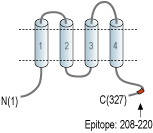Overview
- Peptide (C)EKNKELRFKTKRE, corresponding to amino acid residues 208-220 of rat CACNG4 (Accession Q8VHW9). Intracellular, C-terminus.

 Western blot analysis of rat brain (lanes 1 and 5), mouse brain (lanes 2 and 6), human SH-SY5Y brain neuroblastoma (lanes 3 and 7) and rat PC12 pheochromocytoma adrenal gland (lanes 4 and 8) lysates:1-4. Anti-CACNG4 Antibody (#ACC-114), (1:800).
Western blot analysis of rat brain (lanes 1 and 5), mouse brain (lanes 2 and 6), human SH-SY5Y brain neuroblastoma (lanes 3 and 7) and rat PC12 pheochromocytoma adrenal gland (lanes 4 and 8) lysates:1-4. Anti-CACNG4 Antibody (#ACC-114), (1:800).
5-8. Anti-CACNG4 Antibody, preincubated with CACNG4 Blocking Peptide (#BLP-CC114).
Human islet beta cells (see Luan, C. et al. (2019) Commun. Biol. 2, 106.).
- Tsunemi, T. et al. (2002) J. Biol. Chem. 277, 7214.
- Scheuber, A. et al. (2004) J. Neurosci. 24, 10402.
- Burgess, D.L. et al. (1999) Genome Res. 9, 1204.
- Korber, C. et al. (2007) J. Neurosci. 27, 8442.
Voltage dependent Ca2+ channels (CaV channels) are pivotal players in many physiological roles such as secretion, contraction migration and excitation1.
They are composed of several subunits; α1, β, α2δ and γ. CaV channels were originally divided into six physiological types: L, N, P, Q, R, and T type2.
L-type calcium channels are composed of five subunits. CaVγ4, represents one of these subunits, and is one of several γ subunit proteins. It is an integral membrane protein that is thought to stabilize the Ca2+ channel in an inactive (closed) state. The encoding gene is a member of the neuronal Ca2+ channel γ subunit gene subfamily of the PMP-22/EMP/MP20 family and is located in a cluster with two similar gamma subunit-encoding genes3.
CaVγ4, along with CaVγ2, CaVγ3 and CaVγ8 have been associated with AMPA receptors and have been shown to modulate the trafficking of receptors to the plasma membrane as well as electrophysiological key properties4.
Application key:
Species reactivity key:
Anti-CACNG4 Antibody (#ACC-114) is a highly specific antibody directed against an epitope of the rat protein. The antibody can be used in western blot and immunocytochemistry applications. It has been designed to recognize CaVγ4 from rat, mouse, and human samples.
